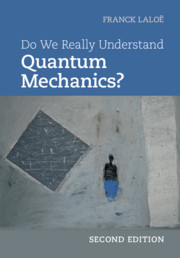Book contents
- Frontmatter
- Contents
- Foreword
- Preface
- Preface to the first edition
- 1 Historical Perspective
- 2 Present Situation, Remaining Conceptual Difficulties
- 3 The Theorem of Einstein, Podolsky, and Rosen
- 4 Bell Theorem
- 5 Other Inequalities, Cirelson’s Limit, Signaling
- 6 More Theorems
- 7 Quantum Entanglement
- 8 Applications of Quantum Entanglement
- 9 Quantum Measurement
- 10 Experiments: Quantum Reduction Seen in Real Time
- 11 Various Interpretations and Reconstructions of Quantum Mechanics
- Conclusion
- 12 Annex: Basic Mathematical Tools of Quantum Mechanics
- Appendix A Mental Content of the State Vector
- Appendix B Bell Inequalities in Nondeterministic Local Theories
- Appendix C Attempting to Construct a “Separable” Quantum Theory
- Appendix D Maximal Probability for a State
- Appendix E The Influence of Pair Selection
- Appendix F Impossibility of Superluminal Communication
- Appendix G Quantum Measurements at Different Times
- Appendix H Manipulating and Preparing Additional Variables
- Appendix I Correlations and Trajectories in Bohmian Theory
- Appendix J Models for Spontaneous Reduction of the State Vector
- Appendix K Consistent Families of Histories
- Appendix L Attractive Schrödinger Dynamics
- References
- Index
- References
References
Published online by Cambridge University Press: 01 February 2019
- Frontmatter
- Contents
- Foreword
- Preface
- Preface to the first edition
- 1 Historical Perspective
- 2 Present Situation, Remaining Conceptual Difficulties
- 3 The Theorem of Einstein, Podolsky, and Rosen
- 4 Bell Theorem
- 5 Other Inequalities, Cirelson’s Limit, Signaling
- 6 More Theorems
- 7 Quantum Entanglement
- 8 Applications of Quantum Entanglement
- 9 Quantum Measurement
- 10 Experiments: Quantum Reduction Seen in Real Time
- 11 Various Interpretations and Reconstructions of Quantum Mechanics
- Conclusion
- 12 Annex: Basic Mathematical Tools of Quantum Mechanics
- Appendix A Mental Content of the State Vector
- Appendix B Bell Inequalities in Nondeterministic Local Theories
- Appendix C Attempting to Construct a “Separable” Quantum Theory
- Appendix D Maximal Probability for a State
- Appendix E The Influence of Pair Selection
- Appendix F Impossibility of Superluminal Communication
- Appendix G Quantum Measurements at Different Times
- Appendix H Manipulating and Preparing Additional Variables
- Appendix I Correlations and Trajectories in Bohmian Theory
- Appendix J Models for Spontaneous Reduction of the State Vector
- Appendix K Consistent Families of Histories
- Appendix L Attractive Schrödinger Dynamics
- References
- Index
- References
- Type
- Chapter
- Information
- Do We Really Understand Quantum Mechanics? , pp. 489 - 526Publisher: Cambridge University PressPrint publication year: 2019



